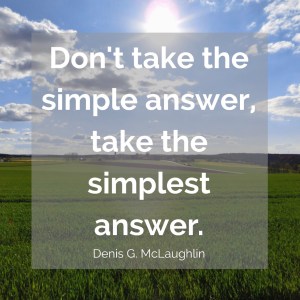Making a decision isn’t always easy. There are times we can take too long because we want to be sure that we have analyzed everything. Albert Einstein pointed out the fallacy in thinking we can be so sure, “Not everything that counts can be counted; not everything that can be counted counts.” So, what’s the answer? How do you know what matters? How do you make quick decisions? How do you read the signs?
A heuristic is a general assumption based on practical experience and not based on observed scientific evidence at the moment. The word heuristic comes from the Greek word heuriskein which means “to discover.” Heuristics are useful in situations where detailed measurements and research are either unavailable or not practical given the time constraints, or when less precision is acceptable. Reading the signs is how experts quickly decide. Realizing that heuristics won’t always give the right answer, sometimes the decision will be to do more research, but even that decision can be made quickly with heuristics.
The game of baseball is an area where heuristics come into play. Major league batters have just about 100 milliseconds to analyze the pitcher and the pitch to decide if they should swing. What can a batter actually see in 100 milliseconds? The seams, spin, and trajectory can be signs of what pitch is coming. There may also be signs from the pitcher directly like the height of the hands or the speed of the release that indicate a certain pitch. From years of experience batters can read these signs. What isn’t happening in the first 100 milliseconds is a physics calculation to determine where and when the ball will come across the plate.
Another example of this would be the phrase “Red sky at night, sailor’s delight. Red sky in the morning, sailor’s warning.” From experience, weather observers understand that these signs are generally reliable indicators of weather patterns. Getting one step closer to the detailed weather predictions is the fact that a red sky at night indicates a sky filled with dust which means a high-pressure zone is in the atmosphere and good weather should follow. A red sky in the morning means that water is in the air and rain will be coming. This heuristic is just an educated assumption and more sophisticated weather models can predict this with much more accuracy, but it’s a fair, quick gauge.
Heuristics can be used for that quick review and analysis of the limited facts in a limited timeframe to make an informed decision. There is a balance between knowing everything and knowing enough to make a decision. Your ability to quickly decide comes from reading the signs; and that comes from study, experience, and asking the right questions.
“If you spend too much time thinking about a thing, you’ll never get it done.” – Bruce Lee
Here’s what you can do to develop your ability to read the signs:
Study – Michelangelo, the artist who painted the ceiling of the Sistine Chapel; the sculptor who brought the statue of David to life; and the architect who designed the dome of St. Peters Basilica. When speaking of the creation of his works of art said, “If people knew how hard I had to work to gain my mastery, it would not seem so wonderful at all.” He studied his craft that allowed him to read the signs described as his ability to, “See the angel in the marble and carve until I set him free.”
If you want to develop your ability to read the signs, seek out all opportunities to learn. Read books, participate in mentoring relationships, attend seminars. Fill your mind with examples of success.
Experience – William Osler, one of the founding doctors of John Hopkins who created the first residency program and instituted bedside clinical training with classroom studies, said of experience, “The value of experience is not in seeing much, but in seeing wisely.” Osler agreed that the study of medicine was an important part of learning, but added the need to experience medicine to be able to read the signs, “He who studies medicine without books sails an uncharted sea, but he who studies medicine without patients does not go to sea at all.”
If you want to develop your ability to read the signs, seek out all opportunities to practice. Volunteer for new projects, try out what you have learned, review the outcomes and try again.
Ask – Neil deGrasse Tyson is the Director of the Hayden Planetarium at the American Museum of Natural History in New York, best-selling author and sought-after speaker. He discussed the importance of being able to ask good questions in this quote, “My investment of time, as an educator, in my judgment, is best served teaching people how to think about the world around them. Teach them how to pose a question. How to judge whether one thing is true versus the other.” Asking the right questions will help you read the signs.
If you want to develop your ability to read the signs, seek out all opportunities to ask questions.
A few questions you should ask to narrow in on the decision are: What do I have to believe for this to be true? What options have been considered? What is the downside of not getting this right?











